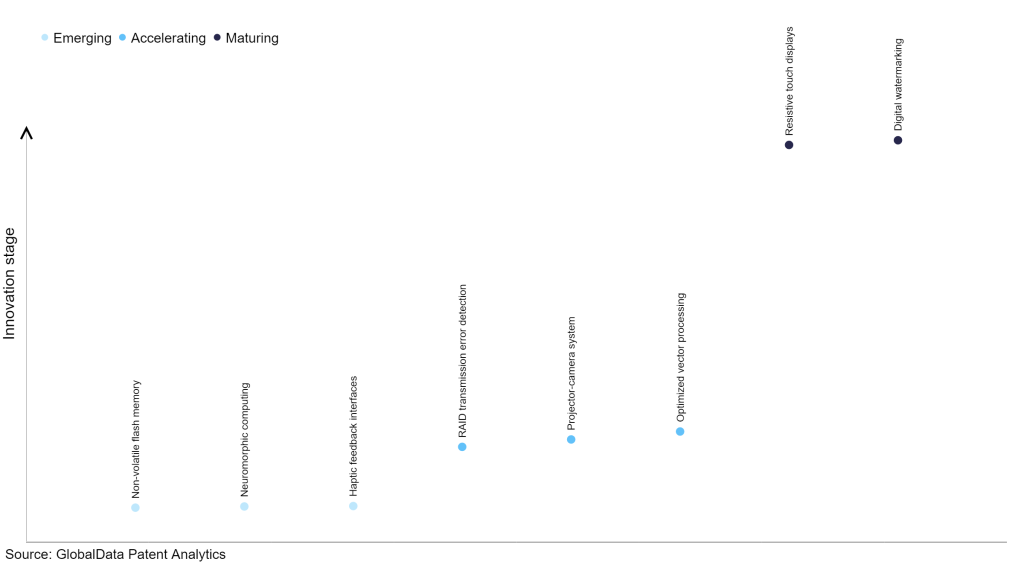The technology industry continues to be a hotbed of patent innovation. Activity is driven by the increasing demand for immersive experiences, advancements in projection and camera technologies, and the growing adoption of virtual meetings and remote collaboration factors driving innovation in the industry. This has resulted in the growing importance of technologies such as high-resolution projectors, depth-sensing cameras, calibration algorithms, and software for image processing and interaction tracking. In the last three years alone, there have been over 1.5 million patents filed and granted in the technology industry, according to GlobalData’s report on Innovation in technology: projector-camera system. Buy the report here.
However, not all innovations are equal and nor do they follow a constant upward trend. Instead, their evolution takes the form of an S-shaped curve that reflects their typical lifecycle from early emergence to accelerating adoption, before finally stabilizing and reaching maturity.
Identifying where a particular innovation is on this journey, especially those that are in the emerging and accelerating stages, is essential for understanding their current level of adoption and the likely future trajectory and impact they will have.
185+ innovations will shape the technology industry
According to GlobalData’s Technology Foresights, which plots the S-curve for the technology industry using innovation intensity models built on over 1.6 million patents, there are 185+ innovation areas that will shape the future of the industry.
Within the emerging innovation stage, non-volatile flash memory, neuromorphic computing, and haptic feedback interfaces are disruptive technologies that are in the early stages of application and should be tracked closely. RAID transmission error detection, projector-camera system, and optimized vector processing are some of the accelerating innovation areas, where adoption has been steadily increasing. Among maturing innovation areas are resistive touch displays and digital watermarking, which are now well established in the industry.
Innovation S-curve for the technology industry

Projector-camera system is a key innovation area in technology
Projector-camera systems are computer vision systems which utilize a combination of projectors and cameras to capture three-dimensional images of objects. By projecting a pattern of light onto the object and capturing the scattered light with a camera, the system gathers data that is analyzed using computer vision algorithms to create a 3D representation of the object.
GlobalData’s analysis also uncovers the companies at the forefront of each innovation area and assesses the potential reach and impact of their patenting activity across different applications and geographies. According to GlobalData, there are 85+ companies, spanning technology vendors, established technology companies, and up-and-coming start-ups engaged in the development and application of projector-camera system.
Key players in projector-camera system – a disruptive innovation in the technology industry
‘Application diversity’ measures the number of applications identified for each patent. It broadly splits companies into either ‘niche’ or ‘diversified’ innovators.
‘Geographic reach’ refers to the number of countries each patent is registered in. It reflects the breadth of geographic application intended, ranging from ‘global’ to ‘local’.
Patent volumes related to projector-camera system
Source: GlobalData Patent Analytics
Sony Group is the top patent filer in the projector-camera system space. One of the company’s patents describes a projection display consisting of an image display device that shows an image, a projection unit that projects the image onto a surface, a light source that illuminates the surface with linear light at a shallow angle, an imaging unit that captures the surface, and a signal processor that processes the captured image. The imaging unit captures the linear light on the surface, and the signal processor corrects any distortion in the projected image based on the captured image of the linear light.
The company’s recently introduced Retina Projection Camera Kit features a laser retina projection technology viewfinder with focus-free retina projection. The new technology projects digital images from the camera directly to the retina allowing visually impaired users a sharper way to view and photograph the world.
Other prominent patent filers in the space include Seiko Epson and Panasonic.
By geographic reach, Compal Electronics leads the pack, followed by Hitachi and Airbus. In terms of application diversity, Hitachi holds the top position, followed by Panasonic and Seiko Epson.
Projector-camera systems can capture three-dimensional images of objects using a combination of projectors and cameras. These systems enable accurate and detailed analysis of object surfaces, which has resulted in their applications in various fields such as 3D modelling, augmented reality, and industrial inspection. By providing a means of reconstructing three-dimensional representations, projector-camera systems offer valuable insights and enable advanced computer vision techniques for enhanced visualization and analysis.
To further understand the key themes and technologies disrupting the technology industry, access GlobalData’s latest thematic research report on Technology.
Data Insights
From

The gold standard of business intelligence.
Blending expert knowledge with cutting-edge technology, GlobalData’s unrivalled proprietary data will enable you to decode what’s happening in your market. You can make better informed decisions and gain a future-proof advantage over your competitors.







